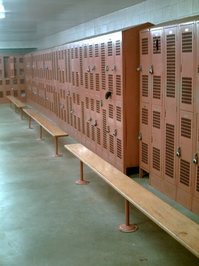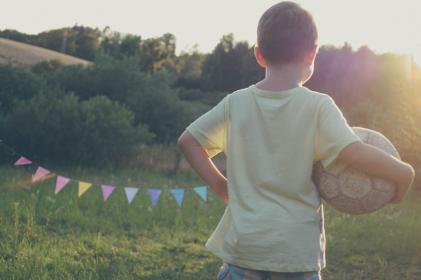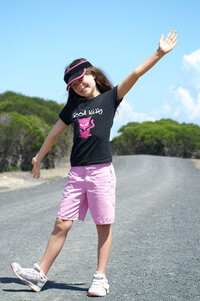Each day as physical education teachers we ask our students to take risks. We ask them to move in front of their peers, join group activities, and publically answer questions. Depending on their physical skill levels, students either see moving in physical education as an opportunity or as a huge threat. As children become older and move through middle and high school they are often even asked to take the risk of undressing in public in gymnasium locker rooms. Rarely do we as educators acknowledge these risks.

At a recent physical education conference I noticed most conference attendees were willing to take the risk of joining in physical activities. However, at a conference last winter it was a different scene. The only activity movers were a few brave participants plus some college students who were required to participate. This situation got me thinking, “What was the difference? And how does this apply to other PE teaching situations?”
I began to think about my own risk-taking comfort. When I am at a professional conference I almost always join in the activity. I know that by joining in I am more likely to remember the activity and pick up on all the little nuances the presenter uses during the activity.
But sometimes I feel very self-conscious during these activities, especially when there is a large group sitting on the edges of the presentation just observing, or when the presenter puts some of us on the spot. For example, if a presenter I don’t know unexpectedly calls on me saying something like, “Lynn, please show the group how you perform the dance move,” my palms sweat, I want to retreat to the back of the room, and I do my best to avoid eye contact with everyone. In contrast, when I know the presenter, am familiar with their non-threatening communication style or view them my friend, I don’t feel the same anxiety. The difference is that I know I can trust them.

Here’s my train of thought when I think about risk-taking when teaching my own elementary-aged students:
What: Helping students learn to take risks
Why: I want my students to feel comfortable enough that they are willing to take social risks (e.g. working with new partners, joining new groups, speaking up in discussions, encouraging teammates etc.) I want my students to feel comfortable enough so that they are willing to take physical risks (e.g. trying new tasks, learning new skills, experimenting with new skills, and attempting skill refinement.)
How: Creating a safe environment that supports risk taking.
Desired Outcome: Students feel comfortable enough to take risks which in turn enhances their participation levels. Students learn the skills and benefits of taking positive physical and social risks, often leading them to take positive social and physical risks outside of the gymnasium.
Answering “How”
Solving the “How” question when trying to get students comfortable with taking risks is the key challenge. I’m fiercely opposed to the practice of using grades as an effective way to get students to take risks. Just look at the majority of PE classes across the country where students are required to “dress out.” Punishment for not dressing out is sufficient motivation for some students. But for others, when weighing their options – getting an ‘F’ in PE or getting undressed in front of others in the locker room – they might decide not dressing out is the less risky of the two. So if threatening with grades, calls home, public humiliation doesn’t work, then we must ask ourselves, “What works?” Research tells us that when people feel safe they are more willing to take risks. So when students are not feeling safe, they are already feeling at risk just being present in our gymnasiums. It’s important then that physical educators provide safe settings if we want students to take risks.

How do we assure we are proving students a safe physical education setting?
This often does not look like the same for every student, but can be attained by adjusting our teaching, environment, equipment and expectations so that each student has equal opportunity for success.
Be Inclusive
The first step to providing a safe physical education setting is to create an inclusive learning atmosphere. Our gymnasiums need to be inclusive to ALL STUDENTS, not just our future athletes. Every student should feel that he or she is a valued member of our physical education community. Creating environments that support the learning of all students is a starting point. We can do this by setting the expectation that it is unacceptable for students to exclude or isolate classmates. We also need to set expectations of how students interact with one another, encouraging comments of acceptance and not allowing put-downs. Often as teachers we model accepting behavior, but that’s not enough. We must also teach and have our students practice what inclusion looks like, sounds like, and feels like. Teaching students why and how to be inclusive when making groups and choosing partners, and then accepting individuals differences among their peers is key to creating an inclusive environment.
Create equal opportunities for success
Setting up our environment so all students have equal access to success is another way we can assure student emotional safety. We can do this by offering students equipment choices, intensity level choices, and adjusting proficiency levels so that our expectations match our students’ ability levels. We have to modify activities so that the competition is leveled. Adjusting scoring and passing opportunities can level the activity; we might challenge one student to score a point for hitting the backboard and have a different student score points only for left-handed layups. Another method of giving students equal access to success is teaching children to work like Goldilocks. When activities are too easy or too difficult students need to understand how they can adjust the challenge level so it is “just right.”

Set clear expectations
Setting up our environment so all students understand the protocol, routines and learning expectations helps us maintain emotional safety. This requires us to teach correct (acceptable) behaviors, giving time for rehearsal and feedback, and then reinforcing students’ positive behavior. Setting up an environment where learning targets are clearly displayed and communicated creates an atmosphere where learning is predictable, furthering student emotional safety.
Teach and demonstrate positive communication
Setting up our environment so positive reinforcement, praise and specific feedback permeates our communication is key to providing emotional safety. Occasionally when examining the environment for emotional safety I must reflect on specific times when students are not following safety rules or being disruptive. When this happens I always try to give corrective feedback privately. Often this may be a quiet verbal reminder of our class expectations. If we are spending a great deal of time disciplining students we probably need to turn the mirror on ourselves and reflect on what we might do to differently. When I find myself in this situation I ask myself questions. Was the lesson age and skill level appropriate? Were my instructions short and clear? Did I layer my instructions with practice sessions so students could develop understanding and competency one step at a time?
Make failure acceptable
Another factor in designing an emotionally safe environment is helping students to understand that it is okay to fail. My professional learning network refers to FAIL as Frequent Attempts In Learning. We need to teach our students that in order to progress through the steps involved in learning a skill, all of us must be willing to attempt tasks in which we often initially experience failure. Set the expectation that as teachers we are not anticipating perfection but instead, best attempts. This understanding leads to a growth mindset environment where we as teachers can provide meaningful feedback, encouragement, and praise for risk taking and hard work.
Make the steps-to-success clear
Setting up our environment so all students have a clear understanding of how to progress in knowledge and skill also leads to greater willingness to take risk. We can do this through teaching sequential critical elements and giving continuous specific instructive feedback. Students must understand the goal they are working toward, their next steps, and their strengths and weaknesses. We as teachers need to advocate for their learning and success by giving them multiple opportunities to show mastery in a variety of physical skills and content knowledge.
Build positive personal relationships
Lastly, and perhaps most importantly, to assure our students feel emotionally safe it’s vital to build a positive and trusting relationship with each student. We build these relationships regardless of our students’ ethnicity, gender, athletic ability, or weight. Engage your students in conversations to learn about their personal interests inside and outside of school. Find ways to bring their families into our gymnasiums at health fairs and open houses. Building an emotionally safe environment ensures that students know we genuinely care about them and they can trust us.
Summary
Creating and maintaining an emotionally safe environment sets up the situation where students feel comfortable enough to take social and physical risks such as asking to join a partner, learning a new skill, or engaging in a team activity. When we don’t see all of our students fully engaged we must reflect on what might be holding them back. Simply dismissing students as lazy or not caring doesn’t dig deep enough. Instead we can investigate whether this student feels emotionally safe in our setting and question what we can adjust to assure their safety. Our students are our clients, soon to be making their own decisions regarding their future health and wellbeing. Whether they value physical activity and a healthy lifestyle will largely be determined by their experiences as students in our gymnasiums. The implications of an emotionally safe environment are clear: Not only will students assume greater healthy risk taking in our settings leading to the goal of “50 Million Strong,” but hopefully those successes will build confidence and enjoyment of physical activity outside of school, leading to healthier lifestyles throughout adulthood.
